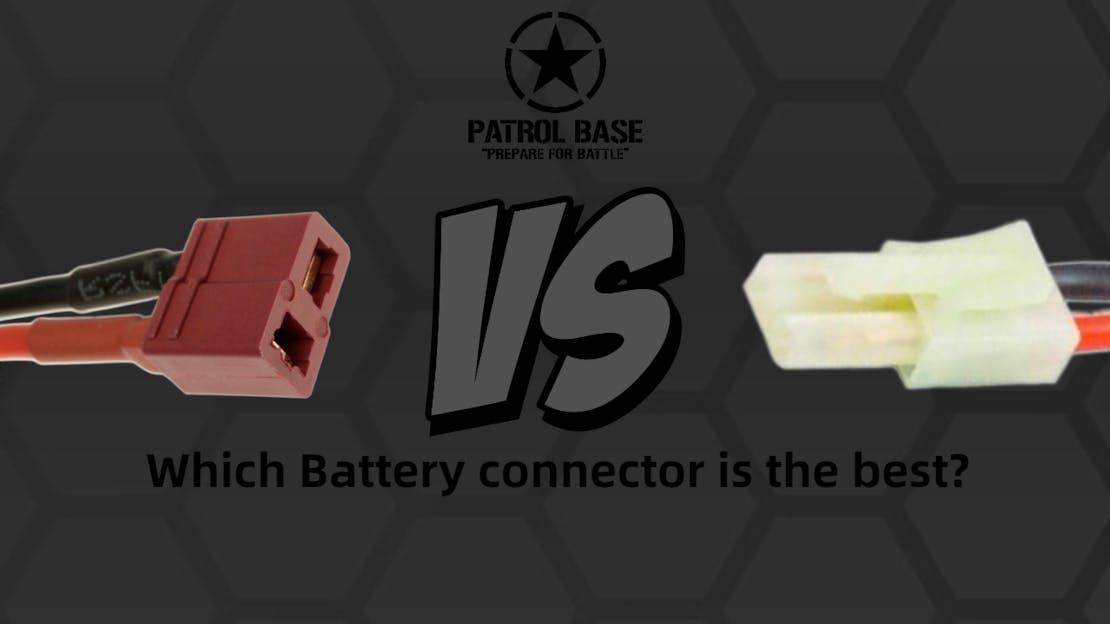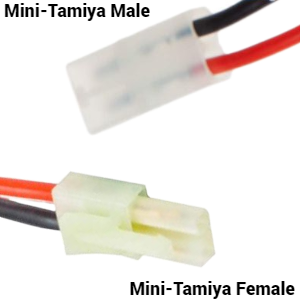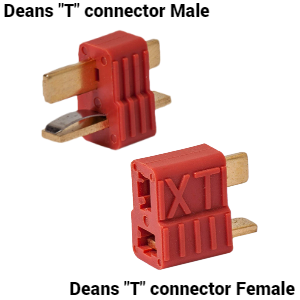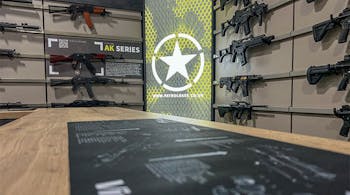
Battery connectors: Deans VS Mini-Tamiya - Which is best?
Battle of the Battery Connectors!
There are many different battery connectors available to Airsofters who are a dab hand with a soldering iron, and the list goes far beyond the two most popular, Deans and Mini-Tamiya. Our intention here is to focus down on the two most popular, and the two which appear most commonly on Airsoft guns and batteries out of the box. So, let the battle of the connectors commence!
Mini-Tamiya
TAMIYA PDV from Patrol Base on Vimeo.

The Mini-Tamiya connector is the most common connector in Airsoft today, by a wide margin. This connector derives from the original Large Tamiya connector which is often found on remote control cars, but in a more compact form. The female connector comprises a polymer shell with a clip and inner copper contacts, and the male connector has a polymer shell without a clip and two inner prong contacts which interface with the cylindrical contacts within the female connector.
The Mini-Tamiya connector is very common and can be found on batteries intended for all sorts of other hobbies, and as such with a Mini-Tamiya you will most likely never be in a situation where you cannot get the battery you need. On the other end of the scale, the Mini-Tamiya is an older design, more suited to low power demands due to its comparatively high resistance, and generally, an AEG with a Mini-Tamiya connector will have a slightly lower rate of fire than the same AEG with a Deans.
Deans (T-Connector)
DEANS PDV from Patrol Base on Vimeo.

The Deans connector is a less common connector, and until recently was regarded as an upgrade for the more technical Airsofter with the need to save battery space, and increase electrical efficiency. The Deans connector is comprised of a polymer shell housing two large copper contacts, and unlike the Tamiya style connectors, the male connector has its contacts entirely exposed. The Deans connector has no clip to connect the male and female connectors, and instead relies on friction to connect the two.
The design of the Deans connector has inherently lower resistance than the Mini-Tamiya connector, and as such is more efficient in delivering power from your battery to your motor. This comes with the balancing factor that the Deans connector is less common and batteries are harder to find, and the exposed contacts create a heightened risk of damage or corrosion if your AEG is not properly cared for. The Deans connector is also quite a bit smaller than the Mini-Tamiya, making it extra useful for those rocking an AEG with a tiny battery compartment; though this was more of a problem before compact LiPo batteries became commonplace.
Advantages and Disadvantages
Deans Connector
Advantages
- Compact size - Perfect for small battery compartments
- Tight fit - Less chance of Electrical Arcing
- Low resistance - Improved rate of fire and electrical efficiency
Disadvantages
- Friction secured - Increased chance of inadvertently disconnecting the battery
- Less common - Batteries are more scarce
- Requires expertise to install - Not recommended for beginners unless the connector is pre-installed
Mini-Tamiya Connector
Advantages
- Common connector - Batteries are easy to find
- Concealed contacts - Less chance of corrosion
- Secured with a clip - Less chance of accidentally disconnecting the battery
Disadvantages
- Higher resistance - Decreased rate of fire and electrical efficiency
- Looser fit - Greater chance of electrical Arcing
- Larger in size - Not ideal for small battery compartments
Common Misconceptions
Using a Mini-Tamiya to Deans adapter and a Deans battery will decrease resistance in the circuit and raise rate of fire.
False! Any additional connectors will reduce the efficiency of the circuit, and lower your rate of fire. Mini-Tamiya to Deans adapters are available, but they are more intended for players who have not yet rewired their AEG to Deans, but have plenty of Deans batteries already in their collection.
A Deans connector is necessary for any AEG with a MOSFET or ETU installed.
Again, this is a simple misunderstanding. An AEG with an ETU or MOSFET installed will benefit more from being wired to a Deans connector, but will still function fine and when wired to a Mini-Tamiya connector. If you are going the whole hog and entirely rewiring your AEG to add a MOSFET or ETU you might as well add a Deans connector while you are at it, but it is by no means essential.
Deans connectors are ONLY for LiPo batteries.
Deans connectors have actually only been hindered in their gradual takeover of Airsoft because of the advent of LiPo batteries and other Lithium-based power sources. These batteries provide much higher current in a much smaller package, and increase rate of fire as well as fitting in smaller battery compartments, stealing the thunder of the low resistance, compact Deans connector. In the past, rewiring to Deans was much more of an essential upgrade back in the days of NiCad and NiMh batteries!
Conclusion
Is the Deans connector better?
Whilst the Mini-Tamiya connector is still the most common connector, slowly but surely manufacturers are moving over to Deans connectors, especially on more complex high performance AEGs with high current draw due to an onboard MOSFET or ETU. The difference in resistance between the two connectors does exist, but as it pertains to the performance of your AEG it is quite minor, and usually results in a Deans AEG shooting around 2rps faster than a Mini-Tamiya equipped AEG.
This increase is nice to have, but the greater difference will come with your AEGs overall wiring setup, and thus installing a Deans connector alone may not be worth the time with the soldering iron, especially if the gun it is being installed on also has another connector closer to the gearbox, which many do. The real improvement in electrical efficiency comes with the installation of an Active Braking MOSFET, and a full re-wire with high gauge wiring, as well as removing any nonessential connectors in the circuit, which only function as a current bottleneck (though these connectors may be in place to allow the AEG to be disassembled more easily).
Whether or not rewiring to Deans is worth the trouble depends entirely on your AEG setup and what you plan to achieve with it. If you are going for the highest rate of fire possible, then a Deans connector is a must. If you desire a more realistic rate of fire of between 600 and 1000 rounds per minute, Deans probably isn't necessary for your purposes. If your AEG has a tiny battery compartment, and you need extra space for a bigger battery, rewiring to deans could save you a couple of cubed centimeters and allow a slightly bigger battery to fit. Worth noting is that a rewire is not recommended for beginners, especially if you have no prior experience with circuits or a soldering iron, and will void any warranty on your AEG.
Is the Mini-Tamiya connector obsolete?
Not even close! The Mini-Tamiya connector is still a very popular connector due to it being more than adequate for most needs in Airsoft. Granted, the venerable Mini connector is not as efficient as Deans, but in most cases that extra bit of efficiency gained by using Deans connectors will not go very far, especially if there are other current bottlenecks in the circuit, such as additional connectors, and if the wiring in the AEG is of a lower gauge. As a rough estimate, approximately 90 percent of Airsoft AEGs use the Mini-Tamiya connector, which has the added benefit that if your battery dies mid skirmish you are very likely to be able to borrow a working battery. This is why many Deans battery users carry an adapter with them, any many AEGs pre-wired to Deans include one in the box. Because you never know if it's going to be a bad battery day!
The Mini-Tamiya connector is not going away any time soon, partially due to the availability of batteries and their cross-compatibility between different hobby spheres, and partially because many Airsofters cannot be bothered with the hassle of changing connectors (we don't blame them!) and until their last Mini-Tamiya gun dies, they stick with what they know!
So, that wraps up our battle of the battery connectors! The conclusion being that, like many aspects of the sport and hobby of Airsoft, it is entirely down to your requirements and what you need, performance-wise, out of your AEG. Whilst we have not concluded that one or the other is better, and many of us use both types of connectors, we hope this information helps you decide what is better for you and your AEG. If you are interested in learning more about all the battery connectors available, check out our guide on battery connectors and its accompanying video.

